Optimizing Territorial Spatial Structures within the Framework of Carbon Neutrality: A Case Study of Wuan
Abstract
1. Introduction
2. Materials and Methods
2.1. Study Area
2.2. Data Resources
2.3. Research Framework
2.4. Quantifying Carbon Emissions/Absorption
2.4.1. Carbon Emissions of Construction Land
2.4.2. Carbon Emissions of Farmland
2.4.3. Carbon Absorption of Farmland
2.4.4. Carbon Absorption of Other Categories
2.5. Spatial Distribution of Carbon Emissions/Absorption
2.6. Forecasting the Land-Use Demand
2.6.1. Markov
2.6.2. MOP
- Model variables
- 2.
- Constraints
- 3.
- Multi-objective function
- (1)
- Coefficients of the carbon emission objective function
- (2)
- Coefficients of the financial benefit objective function
- (3)
- Coefficients of the eco-efficiency objective function
2.7. Simulation of Territorial Space
2.7.1. Factors Driving Land-Use Change
2.7.2. Configuration of Parameters under Different Scenarios
3. Results
3.1. Changes in Territorial Spatial Structure
3.2. Patterns in Both Space and Time of Carbon Emissions
3.3. Simulation Results
3.3.1. Verification of the Model Accuracy
3.3.2. Territorial Spatial Patterns
3.3.3. Land-Use Structures and Land-Use Transfers
3.3.4. Typical Regional Analyses
3.4. Comparison of Carbon Neutrality
4. Discussion
4.1. Rationality of the Research Methodology
4.2. Interaction between Territorial Spatial Planning and Carbon Neutrality
4.3. Correlations between Land-Use Change and Carbon Emissions
4.4. Pathways to Carbon Neutrality
4.5. Limitations of the Study and Directions for Improvement
5. Conclusions
Author Contributions
Funding
Data Availability Statement
Acknowledgments
Conflicts of Interest
References
- Lade, S.J.; Steffen, W.; de Vries, W.; Carpenter, S.R.; Donges, J.F.; Gerten, D.; Hoff, H.; Newbold, T.; Richardson, K.; Rockström, J. Human impacts on planetary boundaries amplified by Earth system interactions. Nat. Sustain. 2020, 3, 119–128. [Google Scholar] [CrossRef]
- Vitousek, P.M.; Mooney, H.A.; Lubchenco, J.; Melillo, J.M. Human Domination of Earth’s Ecosystems. Science 1997, 277, 494–499. [Google Scholar] [CrossRef]
- Lai, L.; Huang, X.J.; Yang, H.; Chuai, X.W.; Zhang, M.; Zhong, T.Y.; Chen, Z.G.; Chen, Y.; Wang, X.; Thompson, J.R. Carbon emissions from land-use change and management in China between 1990 and 2010. Sci. Adv. 2016, 2, e1601063. [Google Scholar] [CrossRef]
- Zhao, X.; Ma, X.; Chen, B.; Shang, Y.; Song, M. Challenges toward carbon neutrality in China: Strategies and countermeasures. Resour. Conserv. Recycl. 2022, 176, 105959. [Google Scholar] [CrossRef]
- Foley, J.A.; DeFries, R.; Asner, G.P.; Barford, C.; Bonan, G.; Carpenter, S.R.; Chapin, F.S.; Coe, M.T.; Daily, G.C.; Gibbs, H.K.; et al. Global consequences of land use. Science 2005, 309, 570–574. [Google Scholar] [CrossRef]
- Houghton, R.A.; Hackler, J.L. Emissions of carbon from forestry and land-use change in tropical Asia. Glob. Chang. Biol. 2001, 5, 481–492. [Google Scholar] [CrossRef]
- Le Quéré, C.; Andrew, R.M.; Friedlingstein, P.; Sitch, S.; Hauck, J.; Pongratz, J.; Pickers, P.A.; Korsbakken, J.I.; Peters, G.P. Global Carbon Budget 2018. Earth Syst. Sci. Data 2018, 10, 2141–2194. [Google Scholar] [CrossRef]
- Friedlingstein, P.; Houghton, R.A.; Marland, G.; Hackler, J.; Boden, T.A.; Conway, T.J.; Canadell, J.G.; Raupach, M.R.; Ciais, P.; Le Quéré, C. Update on CO2 emissions. Nat. Geosci. 2010, 3, 811–812. [Google Scholar] [CrossRef]
- Houghton, R.A. Revised estimates of the annual net flux of carbon to the atmosphere from changes in land use and land management 1850–2000. Tellus B Chem. Phys. Meteorol. 2003, 55, 378–390. [Google Scholar] [CrossRef]
- Fryer, J.; Williams, I.D. Regional carbon stock assessment and the potential effects of land cover change. Sci. Total Environ. 2021, 775, 145815. [Google Scholar] [CrossRef]
- Shan, W.; Jin, X.B.; Yang, X.H.; Gu, Z.M.; Han, B.; Li, H.B.; Zhou, Y.K. A framework for assessing carbon effect of land consolidation with life cycle assessment: A case study in China. J. Environ. Manag. 2020, 266, 110557. [Google Scholar] [CrossRef]
- Tang, X.J.; Woodcock, C.E.; Olofsson, P.; Hutyra, L.R. Spatiotemporal assessment of land use/land cover change and associated carbon emissions and uptake in the Mekong River Basin. Remote Sens. Environ. 2021, 256, 112336. [Google Scholar] [CrossRef]
- Zhu, E.Y.; Deng, J.S.; Zhou, M.M.; Gan, M.Y.; Jiang, R.W.; Wang, K.; Shahtahmassebi, A. Carbon emissions induced by land-use and land-cover change from 1970 to 2010 in Zhejiang, China. Sci. Total Environ. 2019, 646, 930–939. [Google Scholar] [CrossRef]
- Tian, S.; Wang, S.; Bai, X.; Luo, G.; Li, Q.; Yang, Y.; Hu, Z.; Li, C.; Deng, Y. Global patterns and changes of carbon emissions from land use during 1992–2015. Environ. Sci. Ecotechnol. 2021, 7, 100108. [Google Scholar] [CrossRef]
- Ke, Y.H.; Xia, L.L.; Huang, Y.S.; Li, S.R.; Zhang, Y.; Liang, S.; Yang, Z.F. The carbon emissions related to the land-use changes from 2000 to 2015 in Shenzhen, China: Implication for exploring low-carbon development in megacities. J. Environ. Manag. 2022, 319, 115660. [Google Scholar] [CrossRef]
- Wang, G.Z.; Han, Q.; de Vries, B. The multi-objective spatial optimization of urban land use based on low-carbon city planning. Ecol. Indic. 2021, 125, 107540. [Google Scholar] [CrossRef]
- Zhou, Y.; Chen, M.X.; Tang, Z.P.; Mei, Z.A. Urbanization, land use change, and carbon emissions: Quantitative assessments for city-level carbon emissions in Beijing-Tianjin-Hebei region. Sustain. Cities Soc. 2021, 66, 102701. [Google Scholar] [CrossRef]
- Eggleston, H.; Buendia, L.; Miwa, K.; Ngara, T.; Tanabe, K. 2006 IPCC Guidelines for National Greenhouse Gas Inventories; Institute for Global Environmental Strategies IGES: Hayama, Japan, 2006. [Google Scholar]
- Houghton, R.A. Why are estimates of the terrestrial carbon balance so different? Glob. Chang. Biol. 2003, 9, 500–509. [Google Scholar] [CrossRef]
- Yu, X.; Kai, A.; Yang, Y.; Gaodi, X.; Chunxia, L. Forest Carbon Storage Trends along Altitudinal Gradients in Beijing, China. J. Resour. Ecol. 2014, 5, 148–156. [Google Scholar] [CrossRef]
- Li, Z.; Sun, Z.; Chen, Y.; Li, C.; Pan, Z.; Harby, A.; Lv, P.; Chen, D.; Guo, J. The net GHG emissions of the China Three Gorges Reservoir: I. Pre-impoundment GHG inventories and carbon balance. J. Clean. Prod. 2020, 256, 120635. [Google Scholar] [CrossRef]
- Gao, F.; Wu, J.; Xiao, J.H.; Li, X.H.; Liao, S.Y.; Chen, W.Y. Spatially explicit carbon emissions by remote sensing and social sensing. Environ. Res. 2023, 221, 115257. [Google Scholar] [CrossRef] [PubMed]
- Wang, G.Z.; Han, Q.; de Vries, B. A geographic carbon emission estimating framework on the city scale. J. Clean. Prod. 2020, 244, 118793. [Google Scholar] [CrossRef]
- Liu, H.J.; Yan, F.Y.; Tian, H. A Vector Map of Carbon Emission Based on Point-Line-Area Carbon Emission Classified Allocation Method. Sustainability 2020, 12, 10058. [Google Scholar] [CrossRef]
- Zhang, X.P.; Liao, Q.H.; Zhao, H.; Li, P. Vector maps and spatial autocorrelation of carbon emissions at land patch level based on multi-source data. Front. Public Health 2022, 10, 1006337. [Google Scholar] [CrossRef] [PubMed]
- Yao, D. Application of GIS remote sensing information integration in eco-environmental quality monitoring. Int. J. Environ. Technol. Manag. 2021, 24, 375–389. [Google Scholar] [CrossRef]
- Wei, X.D.; Yang, J.; Luo, P.P.; Lin, L.G.; Lin, K.L.; Guan, J.M. Assessment of the variation and influencing factors of vegetation NPP and carbon sink capacity under different natural conditions. Ecol. Indic. 2022, 138, 108834. [Google Scholar] [CrossRef]
- Lyu, J.; Fu, X.H.; Lu, C.; Zhang, Y.Y.; Luo, P.P.; Guo, P.; Huo, A.D.; Zhou, M.M. Quantitative assessment of spatiotemporal dynamics in vegetation NPP, NEP and carbon sink capacity in the Weihe River Basin from 2001 to 2020. J. Clean. Prod. 2023, 428, 139384. [Google Scholar] [CrossRef]
- Wang, X.; Zhang, Y.H.; Atkinson, P.M.; Yao, H.Y. Predicting soil organic carbon content in Spain by combining Landsat TM and ALOS PALSAR images. Int. J. Appl. Earth Obs. Geoinf. 2020, 92, 102182. [Google Scholar] [CrossRef]
- Kitamoto, T.; Ueyama, M.; Harazono, Y.; Iwata, T.; Yamamoto, S. Applications of NOAA/AVHRR and Observed Fluxes to Estimate 3 Regional Carbon Fluxes over Black Spruce Forests in Alaska. J. Agric. Meteorol. 2007, 63, 171–183. [Google Scholar] [CrossRef][Green Version]
- Lv, Q.; Liu, H.B.; Wang, J.T.; Liu, H.; Shang, Y. Multiscale analysis on spatiotemporal dynamics of energy consumption CO emissions in China: Utilizing the integrated of DMSP-OLS and NPP-VIIRS nighttime light datasets. Sci. Total Environ. 2020, 703, 134394. [Google Scholar] [CrossRef]
- Luo, H.Z.; Li, Y.Y.; Gao, X.Y.; Meng, X.Z.; Yang, X.H.; Yan, J.Y. Carbon emission prediction model of prefecture-level administrative region: A land-use-based case study of Xi’an city, China. Appl. Energy 2023, 348, 121488. [Google Scholar] [CrossRef]
- Zhou, L.; Dang, X.; Sun, Q.; Wang, S. Multi-scenario simulation of urban land change in Shanghai by random forest and CA-Markov model. Sustain. Cities Soc. 2020, 55, 102045. [Google Scholar] [CrossRef]
- Wang, Z.Y.; Li, X.; Mao, Y.T.; Li, L.; Wang, X.R.; Lin, Q. Dynamic simulation of land use change and assessment of carbon storage based on climate change scenarios at the city level: A case study of Bortala, China. Ecol. Indic. 2022, 134, 108499. [Google Scholar] [CrossRef]
- Yang, Y.; Wang, H.; Li, X.; Huang, X.; Lyu, X.; Tian, H.; Qu, T. How will ecosystem carbon sequestration contribute to the reduction of regional carbon emissions in the future? analysis based on the MOP-PLUS model framework. Ecol. Indic. 2023, 156, 111156. [Google Scholar] [CrossRef]
- Taloor, A.K.; Sharma, S.; Parsad, G.; Jasrotia, R. Land use land cover simulations using integrated CA-Markov model in the Tawi Basin of Jammu and Kashmir India. Geosyst. Geoenviron. 2024, 3, 100268. [Google Scholar] [CrossRef]
- Peng, K.F.; Jiang, W.G.; Deng, Y.; Liu, Y.H.; Wu, Z.F.; Chen, Z. Simulating wetland changes under different scenarios based on integrating the random forest and CLUE-S models: A case study of Wuhan Urban Agglomeration. Ecol. Indic. 2020, 117, 106671. [Google Scholar] [CrossRef]
- Liu, X.P.; Liang, X.; Li, X.; Xu, X.C.; Ou, J.P.; Chen, Y.M.; Li, S.Y.; Wang, S.J.; Pei, F.S. A future land use simulation model (FLUS) for simulating multiple land use scenarios by coupling human and natural effects. Landsc. Urban Plan. 2017, 168, 94–116. [Google Scholar] [CrossRef]
- Li, F.X.; Wang, L.Y.; Chen, Z.J.; Clarke, K.C.; Li, M.C.; Jiang, P.H. Extending the SLEUTH model to integrate habitat quality into urban growth simulation. J. Environ. Manag. 2018, 217, 486–498. [Google Scholar] [CrossRef]
- Liang, X.; Guan, Q.F.; Clarke, K.C.; Liu, S.S.; Wang, B.Y.; Yao, Y. Understanding the drivers of sustainable land expansion using a patch-generating land use simulation (PLUS) model: A case study in Wuhan, China. Comput. Environ. Urban 2021, 85, 101569. [Google Scholar] [CrossRef]
- Yu, Y.; Guo, B.; Wang, C.L.; Zang, W.Q.; Huang, X.Z.; Wu, Z.W.; Xu, M.; Zhou, K.D.; Li, J.L.; Yang, Y. Carbon storage simulation and analysis in Beijing-Tianjin-Hebei region based on CA-plus model under dual-carbon background. Geomat. Nat. Hazards Risk 2023, 14, 2173661. [Google Scholar] [CrossRef]
- Rong, T.Q.; Zhang, P.Y.; Zhu, H.R.; Jiang, L.; Li, Y.Y.; Liu, Z.Y. Spatial correlation evolution and prediction scenario of land use carbon emissions in China. Ecol. Inform. 2022, 71, 101802. [Google Scholar] [CrossRef]
- Fan, L.; Cai, T.; Wen, Q.; Han, J.; Wang, S.; Wang, J.; Yin, C. Scenario simulation of land use change and carbon storage response in Henan Province, China: 1990–2050. Ecol. Indic. 2023, 154, 110660. [Google Scholar] [CrossRef]
- Li, L.; Chen, Z.C.; Wang, S.D. Optimization of Spatial Land Use Patterns with Low Carbon Target: A Case Study of Sanmenxia, China. Int. J. Environ. Res. Public Health 2022, 19, 14178. [Google Scholar] [CrossRef]
- Xu, X.L.; Wang, S.Y.; Rong, W.Z. Construction of ecological network in Suzhou based on the PLUS and MSPA models. Ecol. Indic. 2023, 154, 110740. [Google Scholar] [CrossRef]
- Zhang, W.; Ma, L.; Wang, X.; Chang, X.; Zhu, Z. The impact of non-grain conversion of cultivated land on the relationship between agricultural carbon supply and demand. Appl. Geogr. 2024, 162, 103166. [Google Scholar] [CrossRef]
- Fan, Y.; Liang, Q.M.; Wei, Y.M.; Okada, N. A model for China’s energy requirements and CO2 emissions analysis. Environ. Modell. Softw. 2007, 22, 378–393. [Google Scholar] [CrossRef]
- Dachraoui, M.; Sombrero, A. Effect of tillage systems and different rates of nitrogen fertilisation on the carbon footprint of irrigated maize in a semiarid area of Castile and Leon, Spain. Soil Tillage Res. 2020, 196, 104472. [Google Scholar] [CrossRef]
- Cheng, K.; Pan, G.; Smith, P.; Luo, T.; Li, L.; Zheng, J.; Zhang, X.; Han, X.; Yan, M. Carbon footprint of China’s crop production—An estimation using agro-statistics data over 1993–2007. Agric. Ecosyst. Environ. 2011, 142, 231–237. [Google Scholar] [CrossRef]
- Zhang, Y.; Fang, G. Research on Spatial-temporal Characteristics and Affecting Factors Decomposition of Agricultural Carbon Emission in Suzhou City, Anhui Province, China. Appl. Mech. Mater. 2013, 291–294, 1385–1388. [Google Scholar] [CrossRef]
- Wu, H.Y.; Sipiläinen, T.; He, Y.; Huang, H.J.; Luo, L.X.; Chen, W.K.; Meng, Y. Performance of cropland low-carbon use in China: Measurement, spatiotemporal characteristics, and driving factors. Sci. Total Environ. 2021, 800, 149552. [Google Scholar] [CrossRef] [PubMed]
- Song, S.; Kong, M.; Su, M.; Ma, Y. Study on carbon sink of cropland and influencing factors: A multiscale analysis based on geographical weighted regression model. J. Clean. Prod. 2024, 447, 141455. [Google Scholar] [CrossRef]
- Hillier, J.; Hawes, C.; Squire, G.; Hilton, A.; Wale, S.; Smith, P. The carbon footprints of food crop production. Int. J. Agric. Sustain. 2009, 7, 107–118. [Google Scholar] [CrossRef]
- She, W.; Wu, Y.; Huang, H.; Chen, Z.; Cui, G.; Zheng, H.; Guan, C.; Chen, F. Integrative analysis of carbon structure and carbon sink function for major crop production in China’s typical agriculture regions. J. Clean. Prod. 2017, 162, 702–708. [Google Scholar] [CrossRef]
- Zhao, R.; Qin, M. Temporospatial variation of partial carbon source/sink of farmland ecosystem in coastal China. J. Ecol. Rural. Environ. 2007, 23, 1–6. [Google Scholar]
- Fang, J.; Guo, Z.; Piao, S.; Chen, A. Terrestrial vegetation carbon sinks in China, 1981–2000. Sci. China Ser. D Earth Sci. 2007, 50, 1341–1350. [Google Scholar] [CrossRef]
- Fang, J.Y.; Chen, A.P.; Peng, C.H.; Zhao, S.Q.; Ci, L. Changes in forest biomass carbon storage in China between 1949 and 1998. Science 2001, 292, 2320–2322. [Google Scholar] [CrossRef] [PubMed]
- Piao, S.; Fang, J.; He, J.; Xiao, Y. Spatial Distribution of Grassland Biomass in China. Chin. J. Plant Ecol. 2004, 28, 491–498. [Google Scholar] [CrossRef]
- Zhang, Y.; Lin, W.; Ren, E.; Yu, Y. Evaluation of spatial distribution of carbon emissions from land use and environmental parameters: A case study in the Yangtze River Delta demonstration zone. Ecol. Indic. 2024, 158, 111496. [Google Scholar] [CrossRef]
- West, T.O.; Marland, G. A synthesis of carbon sequestration, carbon emissions, and net carbon flux in agriculture: Comparing tillage practices in the United States. Agric. Ecosyst. Environ. 2002, 91, 217–232. [Google Scholar] [CrossRef]
- Zhao, R.Q.; Liu, Y.; Tian, M.M.; Ding, M.L.; Cao, L.H.; Zhang, Z.P.; Chuai, X.W.; Xiao, L.G.; Yao, L.G. Impacts of water and land resources exploitation on agricultural carbon emissions: The water-land-energy-carbon nexus. Land Use Policy 2018, 72, 480–492. [Google Scholar] [CrossRef]
- Fattah, M.A.; Morshed, S.R.; Morshed, S.Y. Impacts of land use-based carbon emission pattern on surface temperature dynamics: Experience from the urban and suburban areas of Khulna, Bangladesh. Remote Sens. Appl. 2021, 22, 100508. [Google Scholar] [CrossRef]
- Kováč, D.; Ač, A.; Šigut, L.; Peñuelas, J.; Grace, J.; Urban, O. Combining NDVI, PRI and the quantum yield of solar-induced fluorescence improves estimations of carbon fluxes in deciduous and evergreen forests. Sci. Total Environ. 2022, 829, 154681. [Google Scholar] [CrossRef] [PubMed]
- Hu, Y.F.; Batunacun; Zhen, L.; Zhuang, D.F. Assessment of Land-Use and Land-Cover Change in Guangxi, China. Sci. Rep. 2019, 9, 2189. [Google Scholar] [CrossRef] [PubMed]
- Wang, S.W.; Munkhnasan, L.; Lee, W.-K. Land use and land cover change detection and prediction in Bhutan’s high altitude city of Thimphu, using cellular automata and Markov chain. Environ. Chall. 2021, 2, 100017. [Google Scholar] [CrossRef]
- Cao, K.; Huang, B.; Wang, S.W.; Lin, H. Sustainable land use optimization using Boundary-based Fast Genetic Algorithm. Comput. Environ. Urban 2012, 36, 257–269. [Google Scholar] [CrossRef]
- Hasan, S.S.; Zhen, L.; Miah, M.G.; Ahamed, T.; Samie, A. Impact of land use change on ecosystem services: A review. Environ. Dev. 2020, 34, 100527. [Google Scholar] [CrossRef]
- Costanza, R.; d’Arge, R.; deGroot, R.; Farber, S.; Grasso, M.; Hannon, B.; Limburg, K.; Naeem, S.; ONeill, R.V.; Paruelo, J.; et al. The value of the world’s ecosystem services and natural capital. Nature 1997, 387, 253–260. [Google Scholar] [CrossRef]
- Xie, G.; Zhang, C.; Zhen, L.; Zhang, L. Dynamic changes in the value of China’s ecosystem services. Ecosyst. Serv. 2017, 26, 146–154. [Google Scholar] [CrossRef]
- You, H.; Yang, X. Urban expansion in 30 megacities of China: Categorizing the driving force profiles to inform the urbanization policy. Land Use Policy 2017, 68, 531–551. [Google Scholar] [CrossRef]
- Wu, H.; Lin, A.; Xing, X.; Song, D.; Li, Y. Identifying core driving factors of urban land use change from global land cover products and POI data using the random forest method. Int. J. Appl. Earth Obs. Geoinf. 2021, 103, 102475. [Google Scholar] [CrossRef]
- Li, L.; Huang, X.; Yang, H. Optimizing land use patterns to improve the contribution of land use planning to carbon neutrality target. Land Use Policy 2023, 135, 106959. [Google Scholar] [CrossRef]
- You, L.; Li, Y.R.; Wang, R.; Pan, H.Z. A benefit evaluation model for build-up land use in megacity suburban districts. Land Use Policy 2020, 99, 104861. [Google Scholar] [CrossRef]
- Pan, H.; Yang, T.; Jin, Y.; Dall’Erba, S.; Hewings, G. Understanding heterogeneous spatial production externalities as a missing link between land-use planning and urban economic futures. In Planning Regional Futures; Routledge: London, UK, 2021; pp. 172–192. [Google Scholar] [CrossRef]
- Rajbanshi, J.; Das, S. Changes in carbon stocks and its economic valuation under a changing land use pattern—A multitemporal study in Konar catchment, India. Land Degrad. Dev. 2021, 32, 3573–3587. [Google Scholar] [CrossRef]
- Huang, S.; Xi, F.; Chen, Y.; Gao, M.; Pan, X.; Ren, C. Land Use Optimization and Simulation of Low-Carbon-Oriented—A Case Study of Jinhua, China. Land 2021, 10, 1020. [Google Scholar] [CrossRef]
- Zhu, W.B.; Zhang, J.J.; Cui, Y.P.; Zhu, L.Q. Ecosystem carbon storage under different scenarios of land use change in Qihe catchment, China. J. Geogr. Sci. 2020, 30, 1507–1522. [Google Scholar] [CrossRef]
- Paramesh, V.; Singh, S.K.; Mohekar, D.S.; Arunachalam, V.; Misra, S.D.; Jat, S.L.; Kumar, P.; Nath, A.J.; Kumar, N.; Mahajan, G.R.; et al. Impact of sustainable land-use management practices on soil carbon storage and soil quality in Goa State, India. Land Degrad. Dev. 2021, 33, 28–40. [Google Scholar] [CrossRef]
- He, Z.J.; Deng, M.; Cai, J.N.; Xie, Z.; Guan, Q.F.; Yang, C. Mining spatiotemporal association patterns from complex geographic phenomena. Int. J. Geogr. Inf. Sci. 2020, 34, 1162–1187. [Google Scholar] [CrossRef]
- Liu, Y.S.; Zhou, Y. Territory spatial planning and national governance system in China. Land Use Policy 2021, 102, 105288. [Google Scholar] [CrossRef]

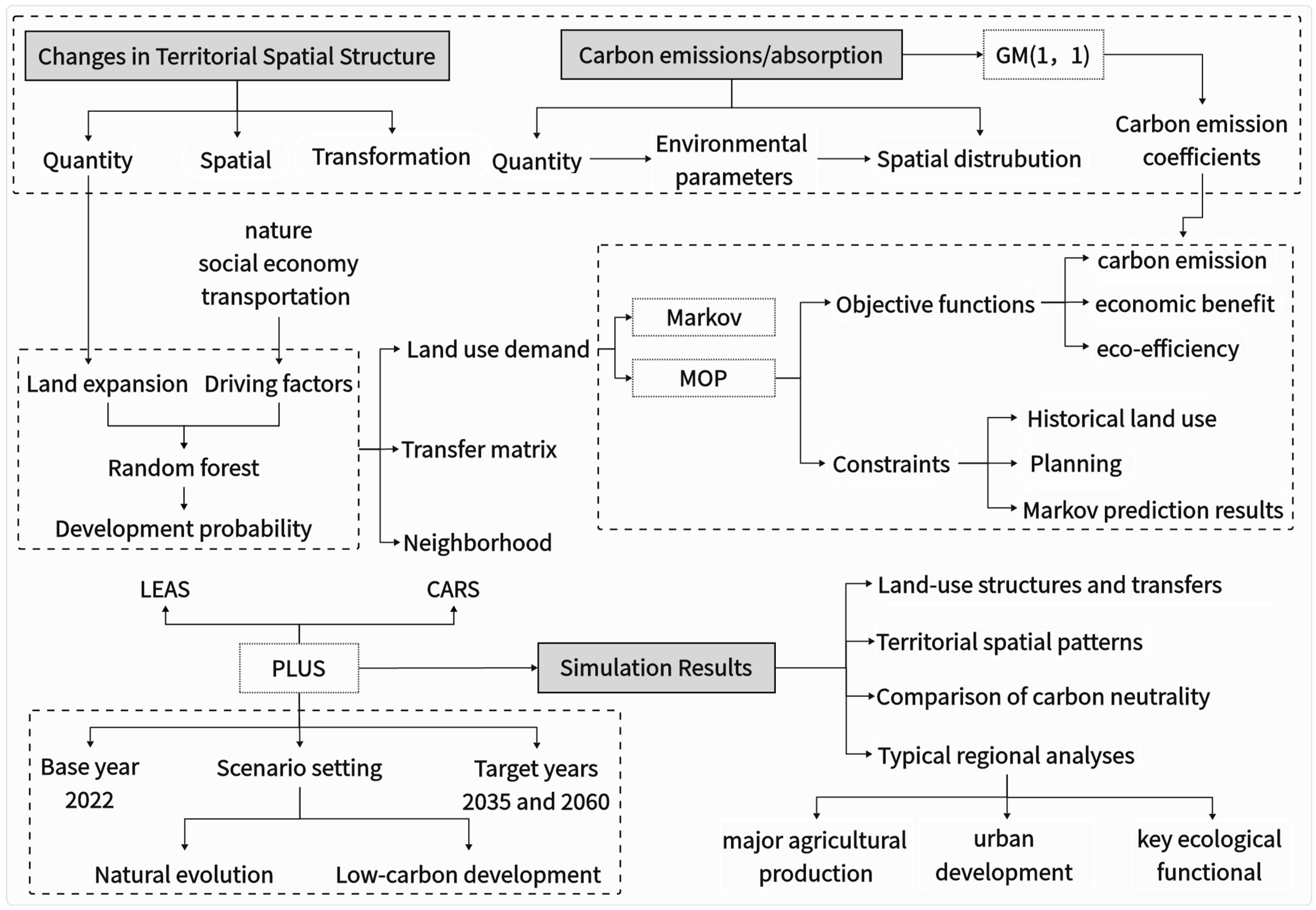
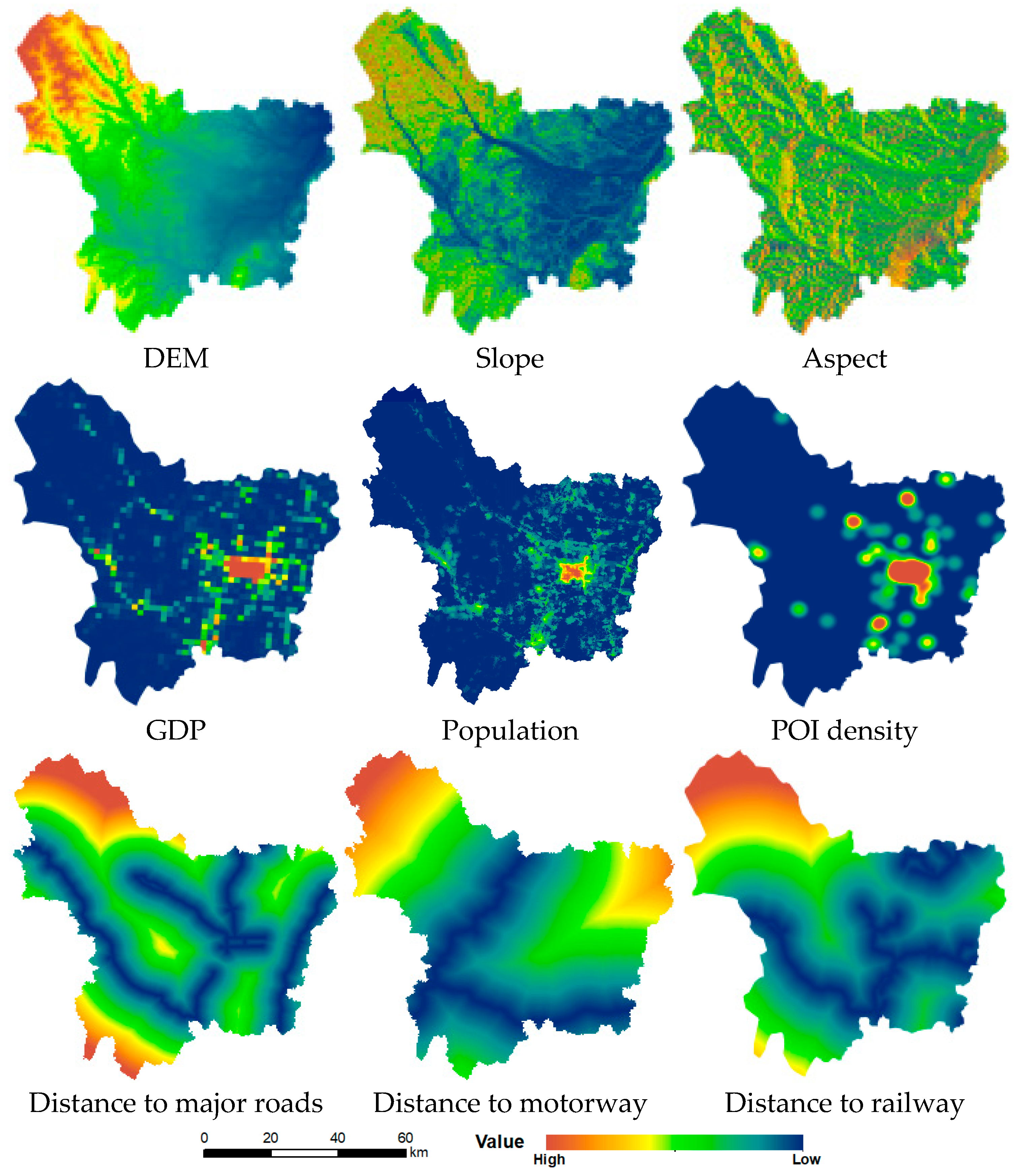
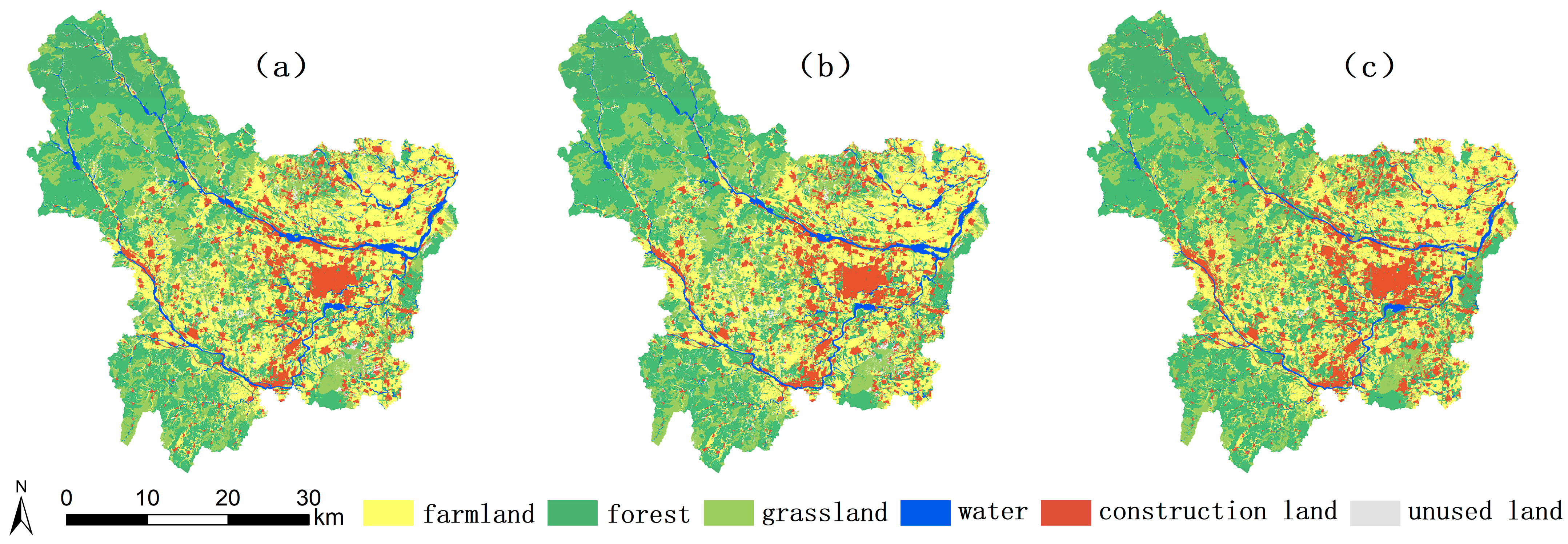
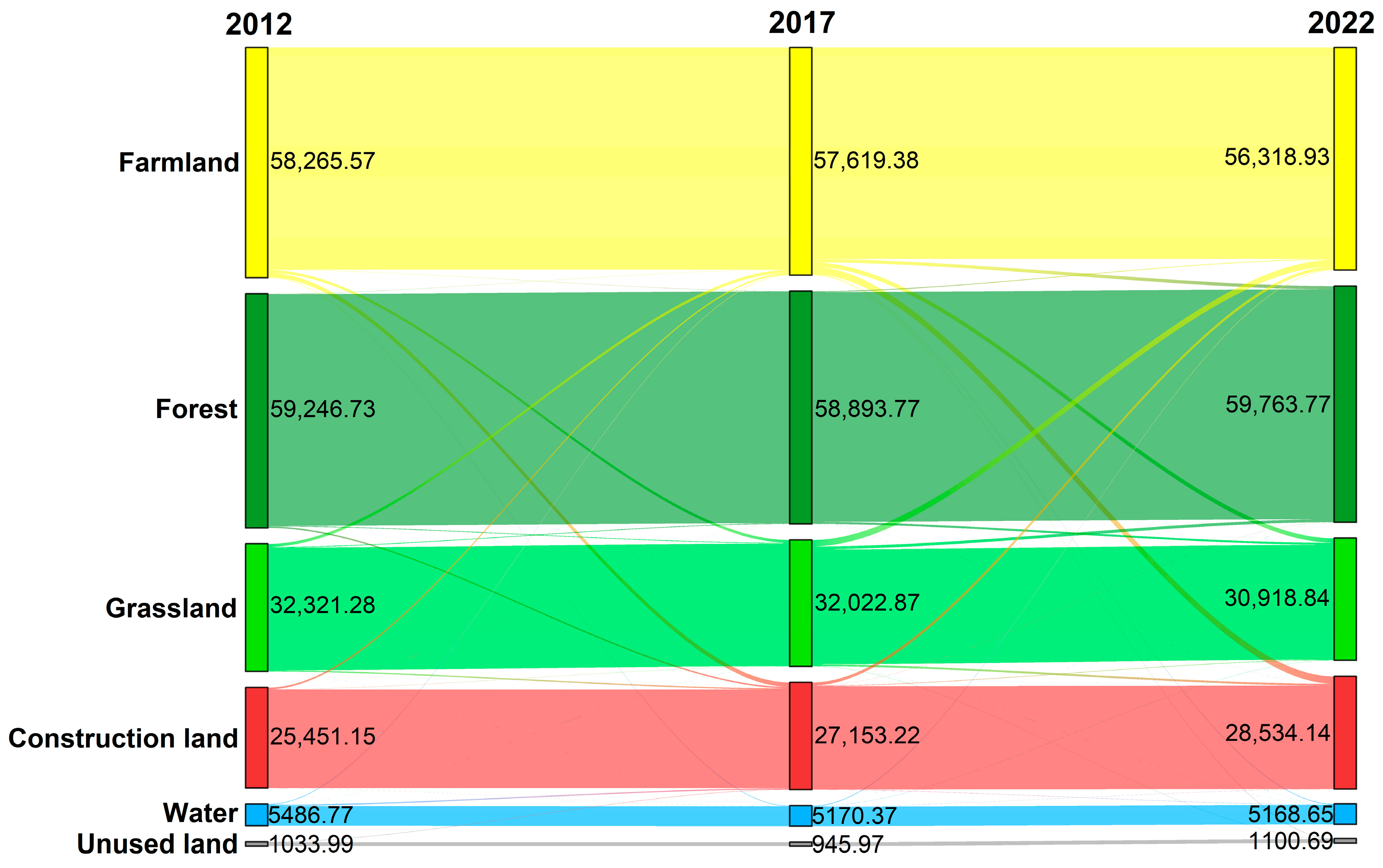


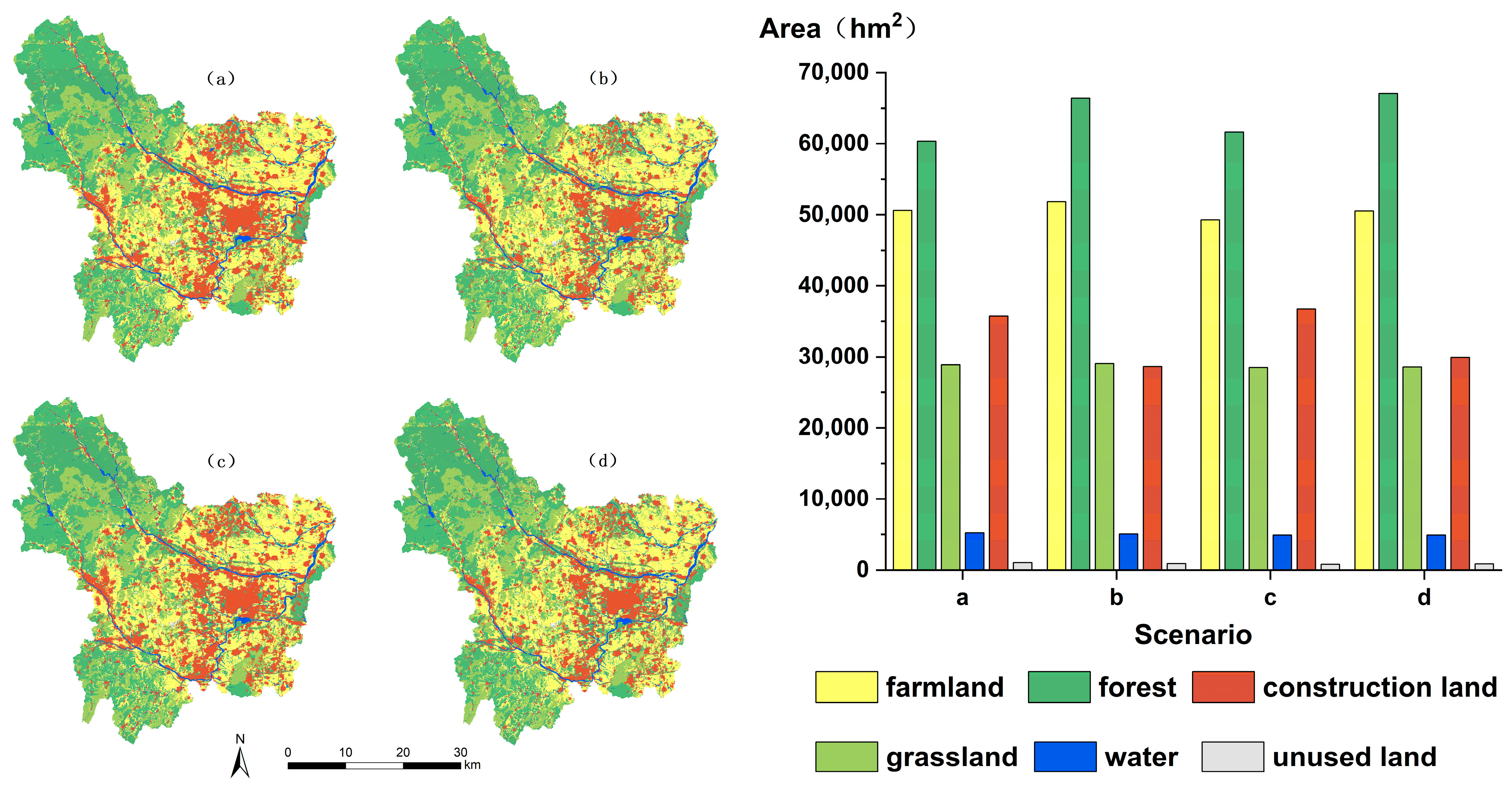
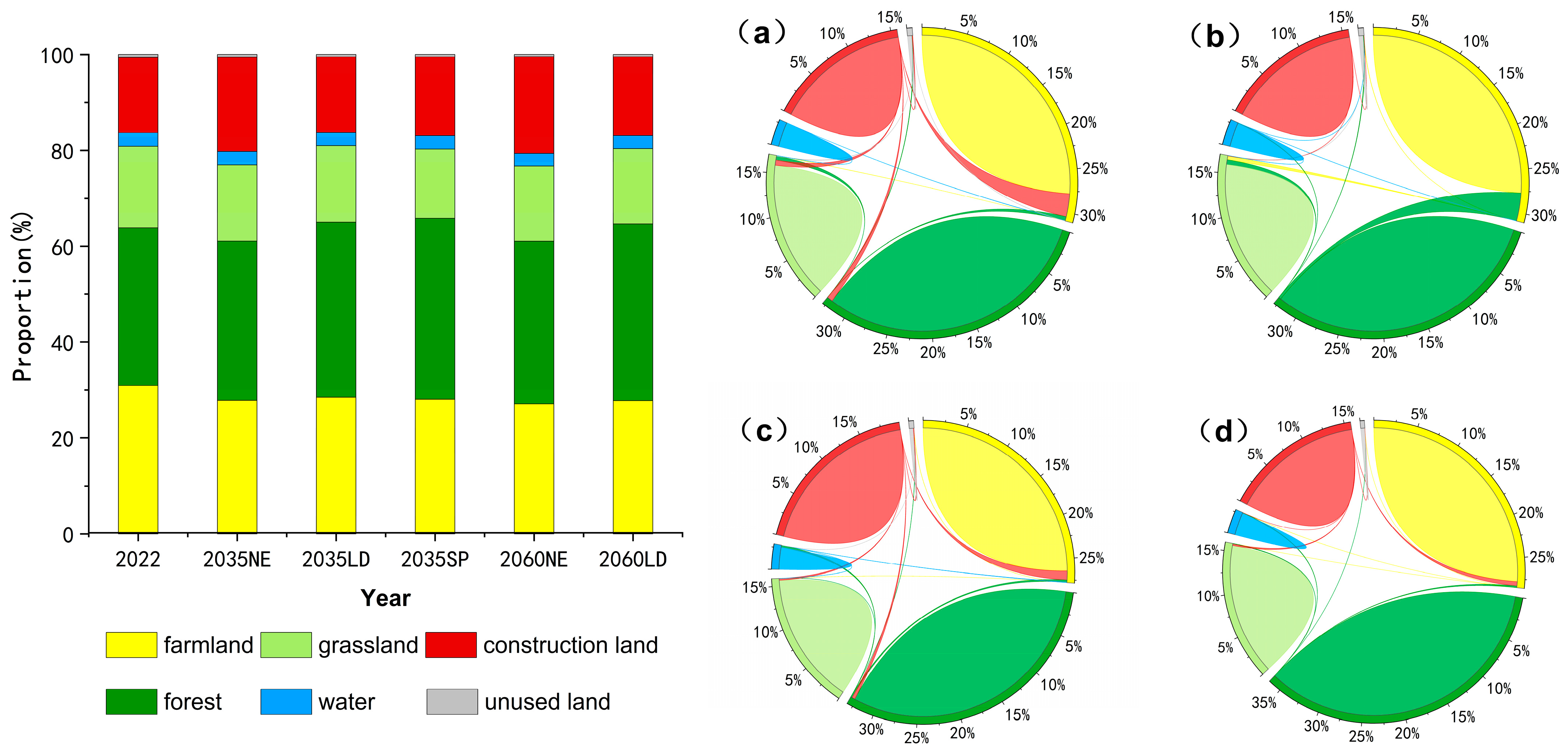
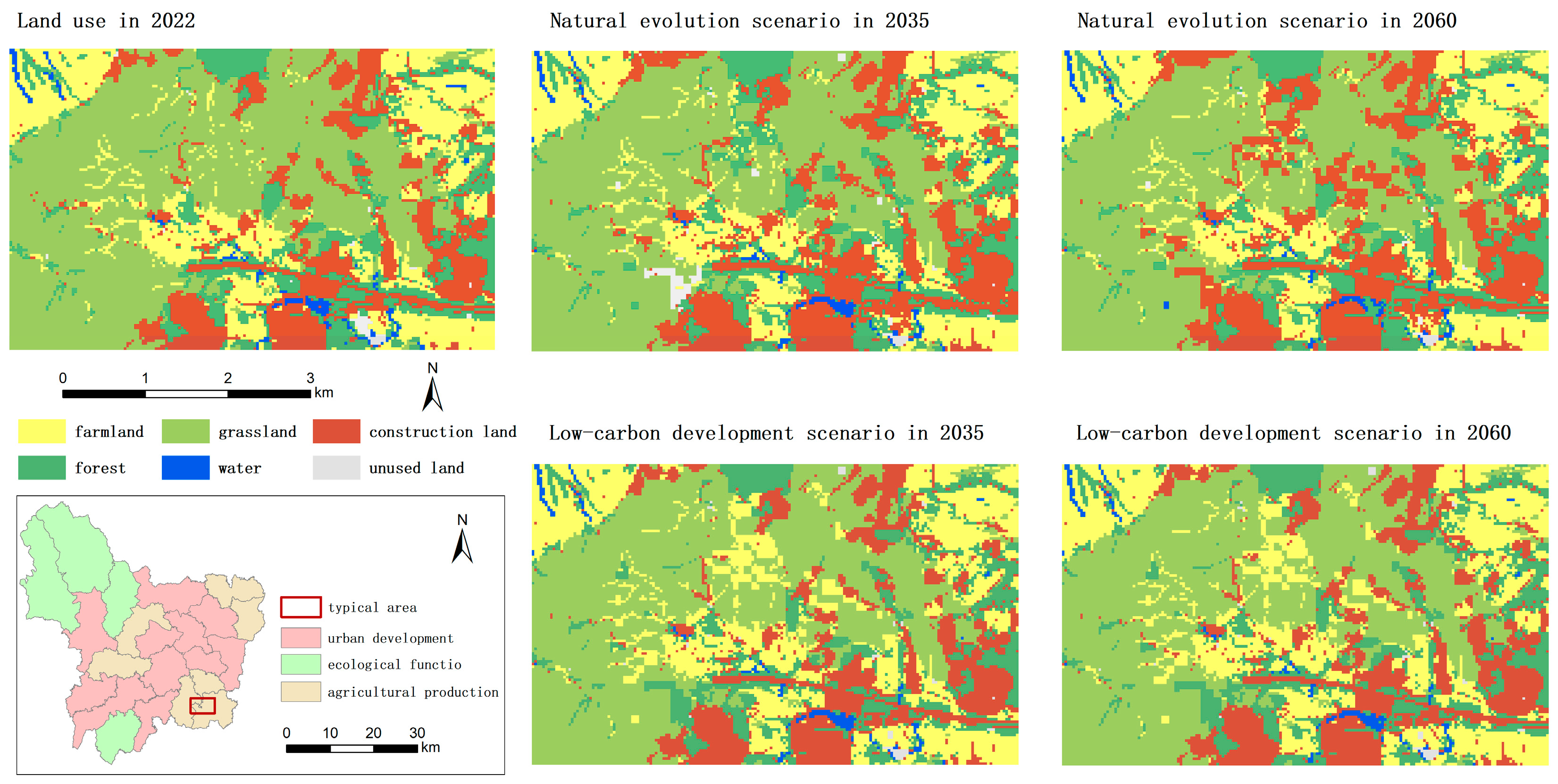
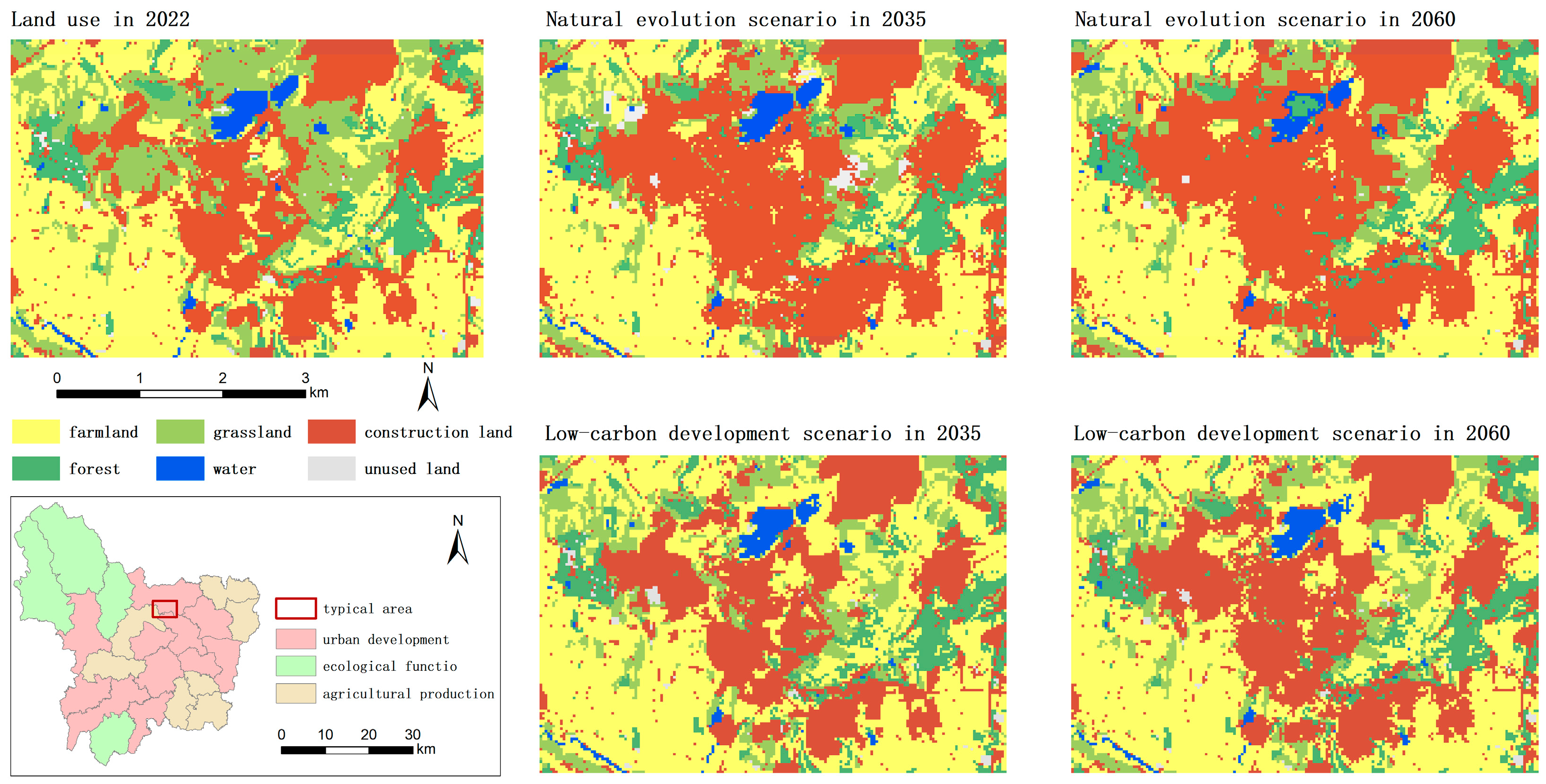

| Type | Name | Data Sources and Processing | |
|---|---|---|---|
| Statistical data | Energy consumption by sector, volume of agricultural production activities, food production, effective irrigated area, total agricultural output, etc. | Wuan Statistical Yearbook (2012–2022) | |
| Planning data | Planning information such as the protective index of farmland, ecological spatial constraints, and the planning targets for each category of area in 2035 | Wuan Territorial Spatial Planning (2021–2035) | |
| Land use data | Land-use change survey data, 2012–2022 | The original vector data were converted to raster data in ArcGIS 10.8and were reclassified into six types of land use. | |
| Environmental parameters | LST | Geographic remote sensing ecological network platform | |
| NDVI | MODIS dataset from USGS | ||
| Driving data | Physical geography | elevation, slope, aspect | The original DEM data obtained from the GDCP were processed in ArcGIS 10.8 to obtain the slope and aspect. |
| Transport accessibility | distance to major roads, motorways, railways | Data on the road network were sourced from OSM and processed in ArcGIS 10.8 using the Euclidean distance tool to obtain transport accessibility. | |
| Socioeconomic | GDP, population density | GDP data were from the Resource and Environment Science and Data Centre. Population density data from the World POP were processed in ArcGIS 10.8. | |
| POI data | Density of points of interest | POI data were from the OSM and processed using the Kernel Density Analysis tool in ArcGIS 10.8. | |
| Type | (TJ/104 t) | (tC/TJ) | |
|---|---|---|---|
| coals | 209.08 | 25.8 | 0.98 |
| coke | 263.44 | 29.2 | 0.98 |
| oven gas | 1735 | 12.1 | 0.995 |
| petroleum | 3893.1 | 15.3 | 0.995 |
| petrol | 430.7 | 20.2 | 0.99 |
| diesel oil | 426.25 | 20.2 | 0.99 |
| Type | Carbon Emission Factor |
|---|---|
| agricultural fertilizers (t/kg) | 8.956 × 10−4 |
| pesticides (t/kg) | 4.934 × 10−3 |
| agricultural plastic film (t/kg) | 5.180 × 10−3 |
| agricultural irrigation (t/hm2) | 2.048 × 10−2 |
| agricultural machinery (t/kw) | 1.800 × 10−4 |
| Type | Barley | Sorghum | Millet | Soya | Potatoes | Oilseeds | Vegetables | Wool | Tobacco | Fruits |
|---|---|---|---|---|---|---|---|---|---|---|
| 0.49 | 0.47 | 0.45 | 0.45 | 0.42 | 0.45 | 0.40 | 0.45 | 0.45 | 0.45 |
| Type | Constraints | Instruction | |
|---|---|---|---|
| 2035 | 2060 | ||
| total area | According to the Wuan Territorial Spatial Planning (2021–2035) (from now on referred to as spatial planning), the total planning area is 181,805 hm2. | ||
| variables | Each type of land use must not be a negative area. | ||
| farmland | According to the spatial planning, the farmland area in 2035 will not be less than 51,022 hm2, which is used as the lower limit in 2035. The Markov projection is taken as the lower limit of the farmland area in 2060. | ||
| forest | Forest, as the most important carbon sink, should become more afforested in the future. The Markov projections were used as the lower limit of forest area in both 2035 and 2060, with a 15% increase as the higher limit. | ||
| grassland | According to the spatial planning, grassland will be reduced to utilize the benefits of the land. Markov projections are used as the lower limit. The 2022 grassland area is the higher limit of 2035. The 2035 MOP projection is the higher limit of that of 2060. | ||
| water | The water area will be reduced. Markov projections are used as higher limits. The spatial planning goal is the lower limit of water area in 2035. The water area in 2060 is the lower limit via a 10% reduction in the Markov projection. | ||
| construction land | Construction land needs to be strictly controlled. The construction land areas in 2035 and 2060 are capped by Markov projections. The 2022 construction land area is the lower limit of 2035. The spatial planning goal is the lower limit of construction area in 2060. | ||
| unused land | According to spatial planning, the efficiency of land use will be improved, so the unused land area will be reduced. The unused land area in 2035 will be capped by 2022, with the planning target as the lower limit. The area of unused land in 2060 will be capped by the planning target in 2035, with the planning target of a 10% reduction as the lower limit. | ||
| Year | Function Expression |
|---|---|
| 2035 | financial benefit: carbon emission: eco-efficiency: |
| 2060 | financial benefit: carbon emission: eco-efficiency: |
| Year | Scenario | Farmland | Forest | Grassland | Water | Construction Land | Unused Land |
|---|---|---|---|---|---|---|---|
| 2035 | Natural evolution | 50,605 | 60,351 | 28,867 | 5226 | 35,730 | 1026 |
| Low-carbon development | 51,802 | 66,406 | 29,022 | 5062 | 28,616 | 897 | |
| 2060 | Natural evolution | 49,294 | 61,627 | 28,478 | 4913 | 36,695 | 798 |
| Low-carbon development | 50,523 | 67,030 | 28,573 | 4900 | 29,930 | 849 |
| Type | Natural Evolution Scenario | Low-Carbon Development Scenario | ||||||||||
|---|---|---|---|---|---|---|---|---|---|---|---|---|
| a | b | c | d | e | f | a | b | c | d | e | f | |
| a | 1 | 1 | 1 | 1 | 1 | 1 | 1 | 1 | 0 | 1 | 1 | 0 |
| b | 1 | 1 | 1 | 1 | 1 | 1 | 1 | 1 | 1 | 1 | 0 | 0 |
| c | 1 | 1 | 1 | 1 | 1 | 1 | 1 | 1 | 1 | 1 | 1 | 1 |
| d | 1 | 1 | 1 | 1 | 0 | 1 | 1 | 1 | 1 | 1 | 0 | 1 |
| e | 0 | 0 | 0 | 0 | 1 | 0 | 0 | 0 | 0 | 0 | 1 | 0 |
| f | 1 | 1 | 1 | 1 | 1 | 1 | 1 | 1 | 1 | 1 | 1 | 1 |
| Scenario | Farmland | Forest | Grassland | Water | Construction Land | Unused Land |
|---|---|---|---|---|---|---|
| Natural evolution | 0.40 | 0.55 | 0.45 | 0.25 | 0.95 | 0.10 |
| Low-carbon development | 0.30 | 0.75 | 0.60 | 0.30 | 0.80 | 0.10 |
| Year | Scenario | Farmland | Forest | Grassland | Water | Construction Land | Unused Land | Carbon Emissions |
|---|---|---|---|---|---|---|---|---|
| 2022 | status | 150,782.67 | −29,895.05 | −617.94 | −232.86 | 314,862.8 | −5.51 | 434,894.12 |
| 2035 | natural | 84,004.33 | −30,175.46 | −577.34 | −235.17 | 349,799.54 | −5.13 | 402,810.77 |
| low-carbon | 85,990.56 | −33,203.01 | −580.45 | −227.79 | 280,151.03 | −4.48 | 332,125.86 | |
| planning | 84,696.52 | −34,286.00 | −526.74 | −227.79 | 292,877.64 | −4.48 | 342,529.15 | |
| 2060 | natural | 40,421.41 | −30,813.46 | −569.57 | −221.06 | 266,037.13 | −3.99 | 274,850.45 |
| low-carbon | 41,429.03 | −33,515.16 | −571.45 | −220.50 | 216,992.36 | −4.24 | 224,110.04 |
Disclaimer/Publisher’s Note: The statements, opinions and data contained in all publications are solely those of the individual author(s) and contributor(s) and not of MDPI and/or the editor(s). MDPI and/or the editor(s) disclaim responsibility for any injury to people or property resulting from any ideas, methods, instructions or products referred to in the content. |
© 2024 by the authors. Licensee MDPI, Basel, Switzerland. This article is an open access article distributed under the terms and conditions of the Creative Commons Attribution (CC BY) license (https://creativecommons.org/licenses/by/4.0/).
Share and Cite
Han, X.; Fu, M.; Wang, J.; Li, S. Optimizing Territorial Spatial Structures within the Framework of Carbon Neutrality: A Case Study of Wuan. Land 2024, 13, 1147. https://doi.org/10.3390/land13081147
Han X, Fu M, Wang J, Li S. Optimizing Territorial Spatial Structures within the Framework of Carbon Neutrality: A Case Study of Wuan. Land. 2024; 13(8):1147. https://doi.org/10.3390/land13081147
Chicago/Turabian StyleHan, Xiangxue, Meichen Fu, Jingheng Wang, and Sijia Li. 2024. "Optimizing Territorial Spatial Structures within the Framework of Carbon Neutrality: A Case Study of Wuan" Land 13, no. 8: 1147. https://doi.org/10.3390/land13081147
APA StyleHan, X., Fu, M., Wang, J., & Li, S. (2024). Optimizing Territorial Spatial Structures within the Framework of Carbon Neutrality: A Case Study of Wuan. Land, 13(8), 1147. https://doi.org/10.3390/land13081147





